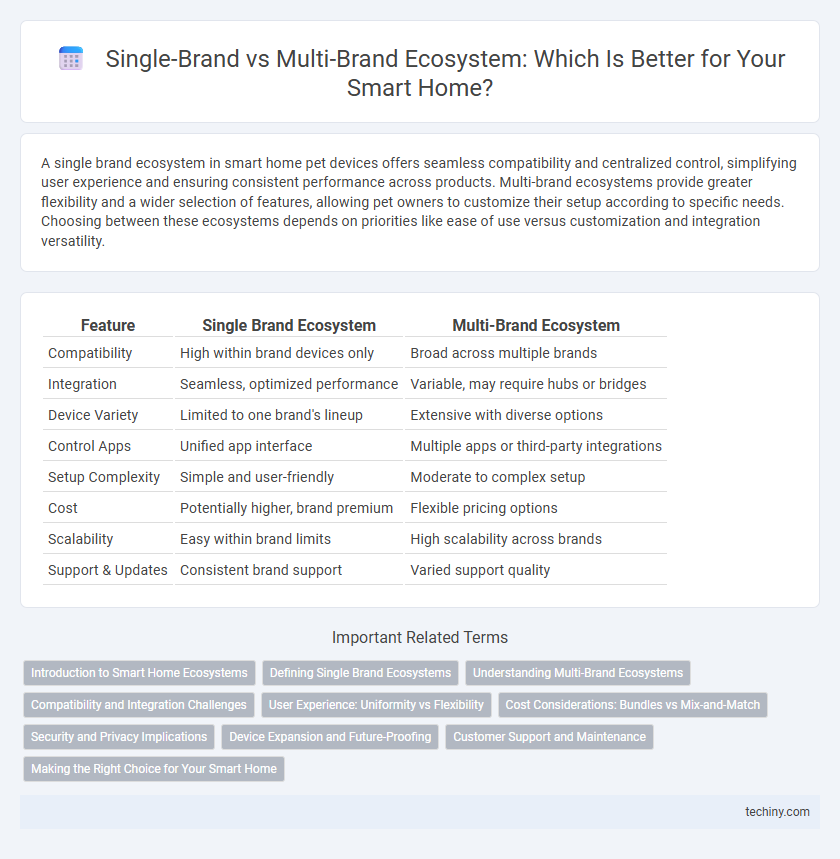A single brand ecosystem in smart home pet devices offers seamless compatibility and centralized control, simplifying user experience and ensuring consistent performance across products. Multi-brand ecosystems provide greater flexibility and a wider selection of features, allowing pet owners to customize their setup according to specific needs. Choosing between these ecosystems depends on priorities like ease of use versus customization and integration versatility.
Table of Comparison
| Feature | Single Brand Ecosystem | Multi-Brand Ecosystem |
|---|---|---|
| Compatibility | High within brand devices only | Broad across multiple brands |
| Integration | Seamless, optimized performance | Variable, may require hubs or bridges |
| Device Variety | Limited to one brand's lineup | Extensive with diverse options |
| Control Apps | Unified app interface | Multiple apps or third-party integrations |
| Setup Complexity | Simple and user-friendly | Moderate to complex setup |
| Cost | Potentially higher, brand premium | Flexible pricing options |
| Scalability | Easy within brand limits | High scalability across brands |
| Support & Updates | Consistent brand support | Varied support quality |
Introduction to Smart Home Ecosystems
Smart home ecosystems integrate devices and services to create a seamless user experience, with single brand ecosystems offering streamlined compatibility and unified control through a dedicated app. Multi-brand ecosystems provide greater device variety and flexibility, enabling users to mix products from different manufacturers while relying on platforms like Apple HomeKit, Google Home, or Amazon Alexa for centralized management. Choosing between single brand and multi-brand ecosystems depends on priorities such as ease of use, device diversity, and ecosystem scalability.
Defining Single Brand Ecosystems
Single brand ecosystems in smart homes offer seamless integration by utilizing devices from one manufacturer, ensuring consistent performance and unified control through a single app. These ecosystems provide enhanced compatibility, simplified setup, and streamlined updates, reducing the complexity often seen in multi-brand environments. Leading single brand ecosystems like Apple HomeKit, Google Nest, and Amazon Alexa create cohesive user experiences driven by optimized hardware and software synergy.
Understanding Multi-Brand Ecosystems
Multi-brand ecosystems in smart homes enable seamless integration of devices from different manufacturers, enhancing flexibility and customization for users. These ecosystems rely on standardized protocols such as Zigbee, Z-Wave, and Matter to ensure interoperability and simplify device management. The diverse compatibility promotes innovation and future-proofs the smart home by accommodating the latest technologies without vendor lock-in.
Compatibility and Integration Challenges
Single brand ecosystems in smart homes offer seamless compatibility and streamlined integration, ensuring all devices communicate efficiently within a unified platform. Multi-brand ecosystems present compatibility challenges due to varying protocols and standards, requiring additional hubs or bridges for device interoperability. Users often face complex setup processes and potential functionality limitations when integrating disparate brands.
User Experience: Uniformity vs Flexibility
A single brand ecosystem offers a seamless and uniform user experience with consistent interfaces, streamlined setup, and reliable interoperability among devices. In contrast, a multi-brand ecosystem provides greater flexibility and a broader range of device options but may require more effort in integration and can lead to inconsistent user interactions. Balancing uniformity with flexibility is crucial for optimizing smart home usability and customization according to individual preferences.
Cost Considerations: Bundles vs Mix-and-Match
Single brand ecosystems often provide cost savings through bundled deals, offering devices and services designed to work seamlessly together under one subscription or purchase plan. Mix-and-match multi-brand ecosystems can incur higher costs due to compatibility issues and the need for additional hubs or adapters, but they offer greater flexibility and customization. Consumers must weigh upfront savings from bundles against potential long-term expenses and the value of tailored smart home solutions.
Security and Privacy Implications
A single brand ecosystem offers enhanced security through uniform software updates and centralized access control, reducing vulnerabilities caused by incompatible devices. Multi-brand ecosystems increase flexibility but pose higher privacy risks due to disparate data handling practices and inconsistent security standards across manufacturers. Consumers prioritizing data protection should weigh the controlled environment of a single brand against the potential exposure in a multi-brand setup.
Device Expansion and Future-Proofing
A single brand ecosystem offers seamless device integration and a unified user experience, allowing consistent updates and reliable compatibility across devices, which strengthens future-proofing. Multi-brand ecosystems provide diverse device options and flexibility, yet may face challenges with interoperability and inconsistent software updates that can hinder scalability. Prioritizing device expansion requires assessing compatibility standards and support longevity to ensure a robust and adaptable smart home environment.
Customer Support and Maintenance
A single brand ecosystem in smart homes offers streamlined customer support and simplified maintenance through centralized service channels and uniform device compatibility. Multi-brand ecosystems can present challenges in troubleshooting due to varied support policies and diverse hardware, often requiring multiple service providers. Customers benefit from a single brand's cohesive support experience, while multi-brand setups demand advanced technical knowledge to manage cross-brand integration and repairs effectively.
Making the Right Choice for Your Smart Home
Choosing between a single-brand ecosystem and a multi-brand ecosystem for your smart home significantly impacts device compatibility and user experience. Single-brand ecosystems like Apple HomeKit or Google Nest offer seamless integration, consistent updates, and unified control, ensuring reliable performance across devices. Multi-brand ecosystems provide greater flexibility and a wider range of products but may require additional effort for compatibility and centralized management.
Single brand ecosystem vs Multi-brand ecosystem Infographic

 techiny.com
techiny.com